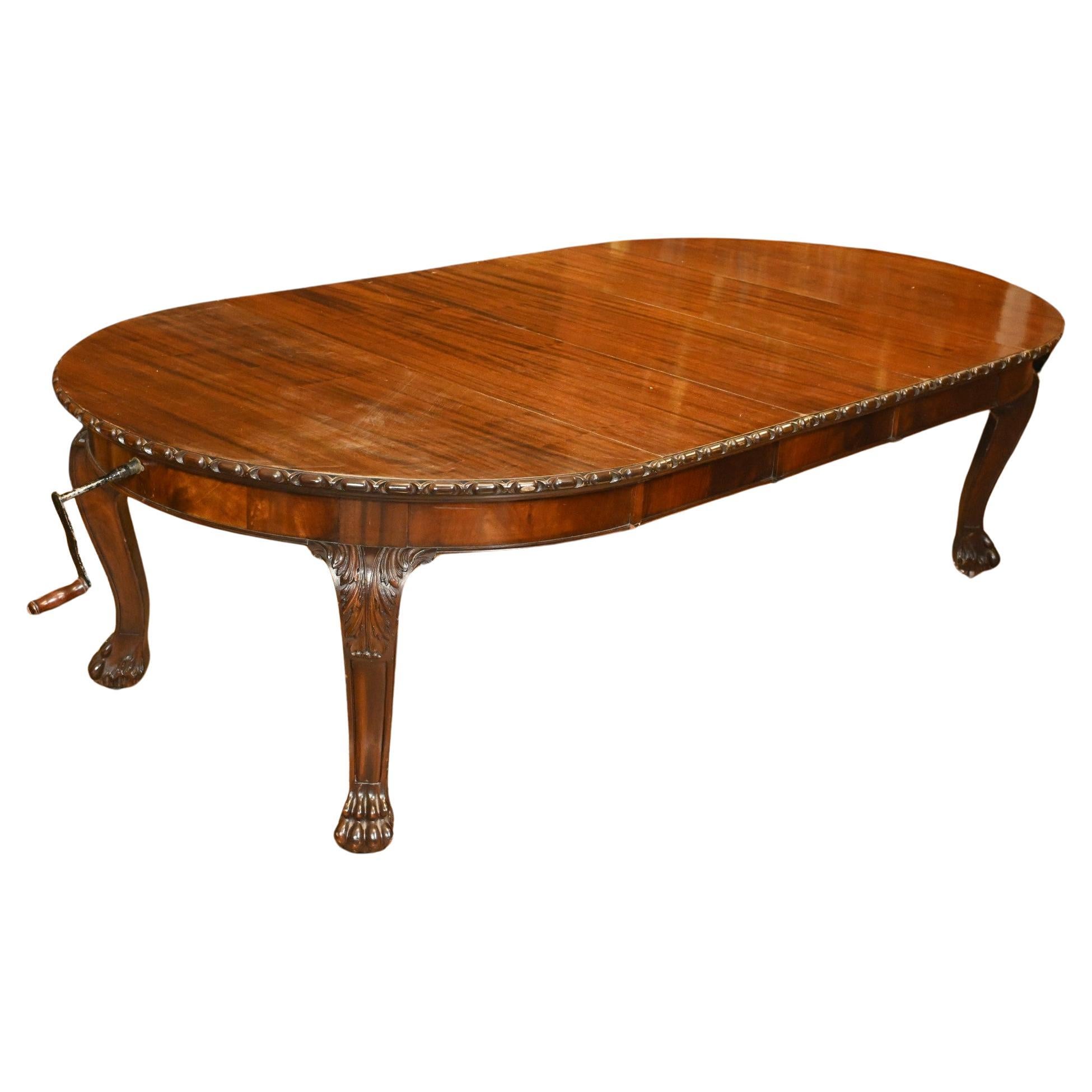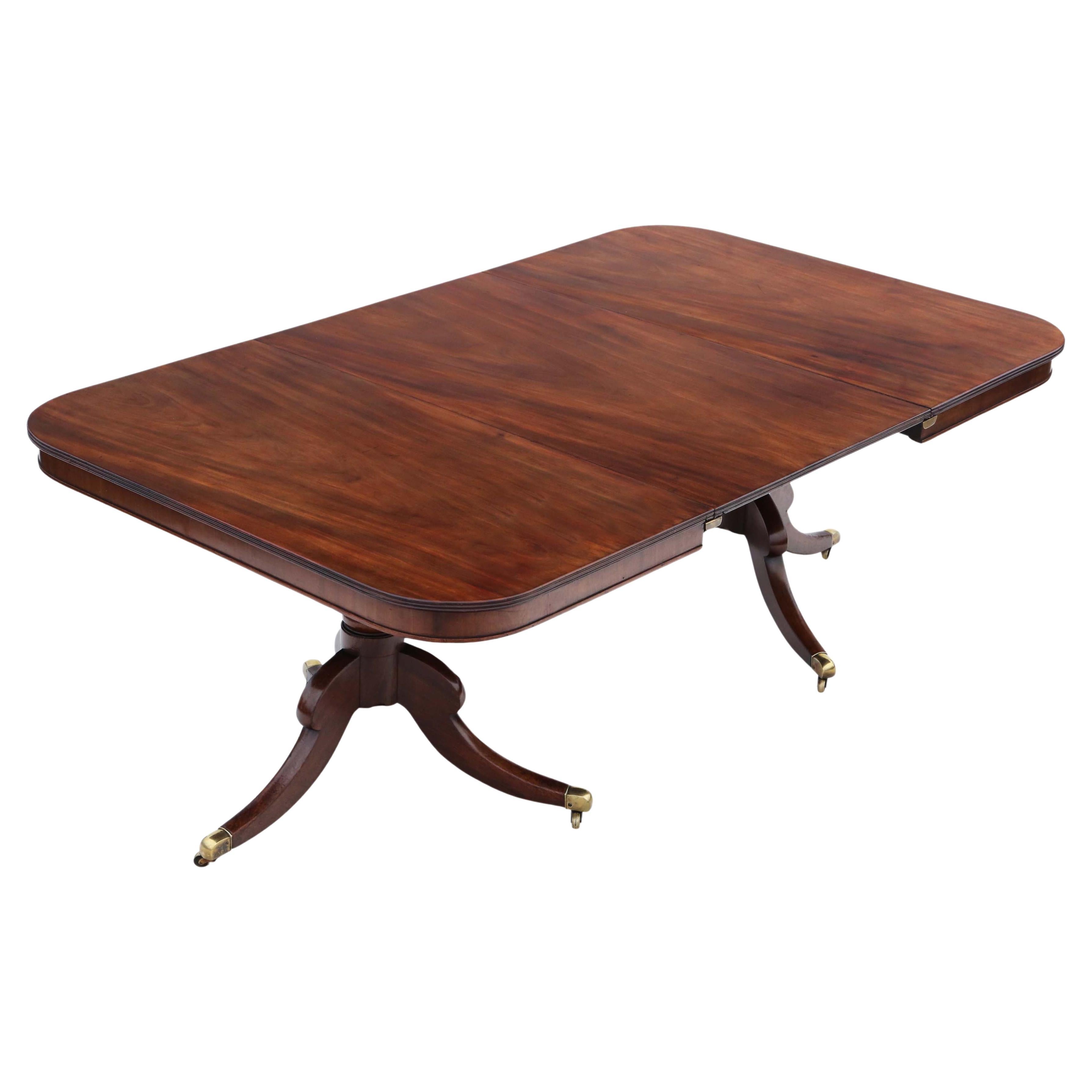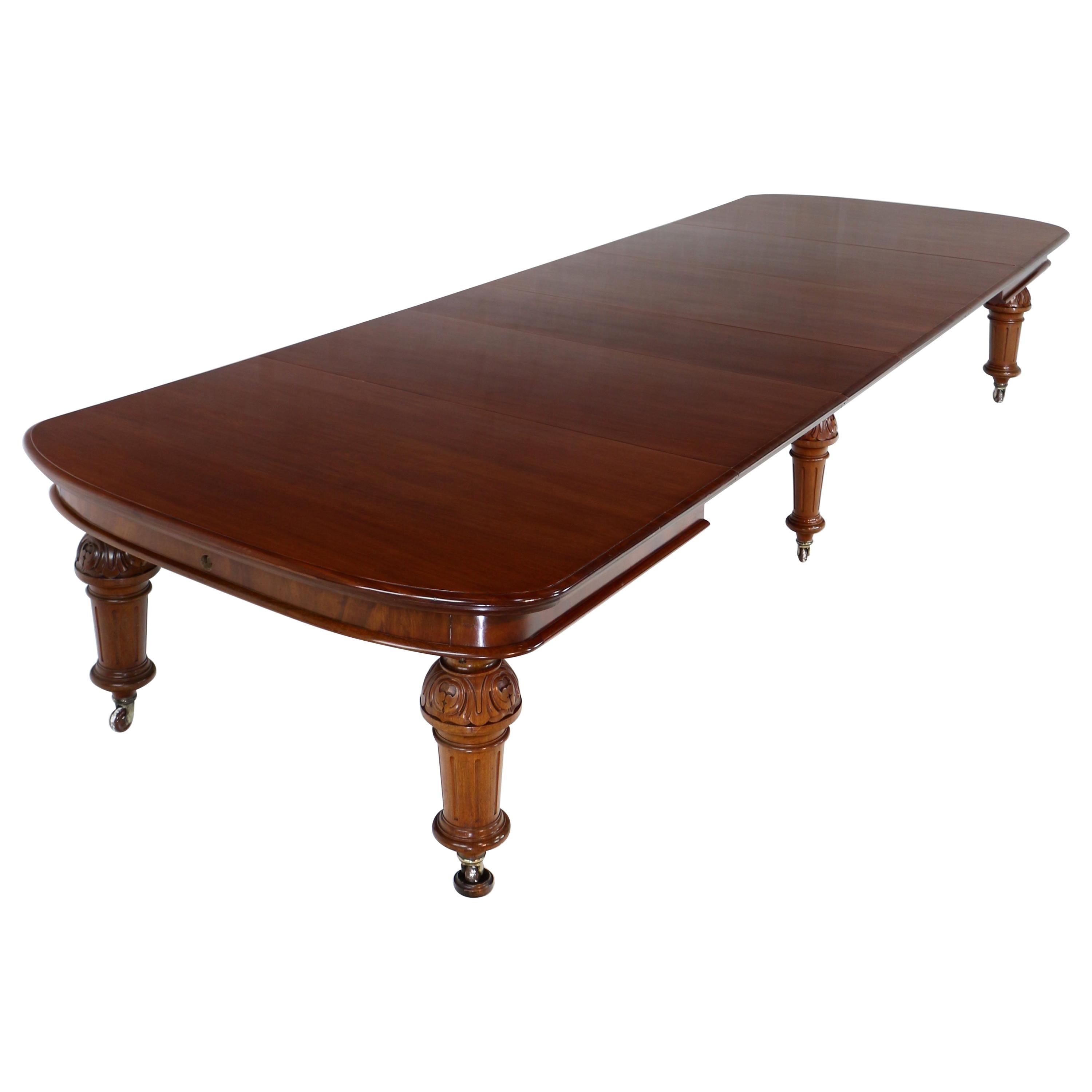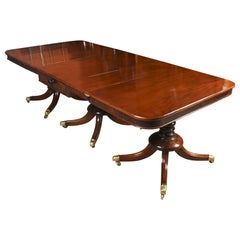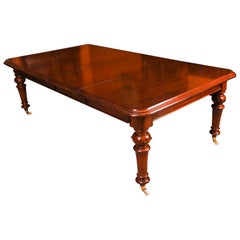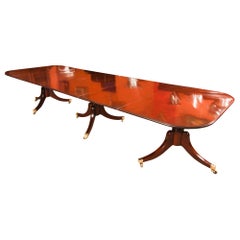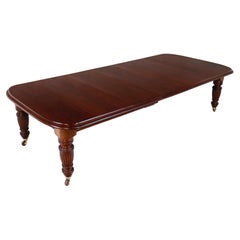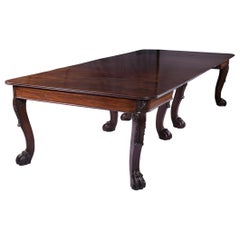Items Similar to Antique Victorian Mahogany Twin Base Extending Dining Table 19th Century
Want more images or videos?
Request additional images or videos from the seller
1 of 21
Antique Victorian Mahogany Twin Base Extending Dining Table 19th Century
$17,381.25
£12,500
€14,797.39
CA$23,726.71
A$26,687.30
CHF 13,842.12
MX$323,736.33
NOK 175,509.85
SEK 165,164.60
DKK 110,392.75
Shipping
Retrieving quote...The 1stDibs Promise:
Authenticity Guarantee,
Money-Back Guarantee,
24-Hour Cancellation
About the Item
A fantastic antique Victorian mahogany and gilded twin pedestal dining table bearing the impressed mark of the renowned cabinet makers and retailers Wylie & Lochhead, and circa 1850 in date.
The oval shaped table is made from solid mahogany and has four leaves which can be added or removed as required to suit the occasion by a special winding mechanism.
It is raised on a pair of beautifully carved and gilded pedestal bases with downswept legs terminating in scroll feet and the original brass and porcelain recessed castors.
Bearing the inventory number 22308 and stamp of the maker:
Wylie & Lochead
45 Buchanan Street
Glasgow
Whatever the function of this gorgeous table, it will make a profound impression on your dinner guests or clients and will receive the maximum amount of attention wherever it is placed.
The chairs shown in the photographs are not included but can be purchased if required.
THE BOTANICAL NAME FOR THE MAHOGANY THAT THIS ITEM IS MADE OF IS SWIETENIA MACROPHYLLA AND THIS TYPE OF MAHOGANY IS NOT SUBJECT TO CITES REGULATION AND DOES NOT CONTAIN ANY RESTRICTED MATERIALS.
Condition:
In excellent condition having been beautifully restored in our workshops, please see photos for confirmation.
Dimensions in cm:
Height 77 x Width 366 x Depth 142 - Fully extended
Height 76 x Width 184 x Depth 142 - With all four leaves removed
Dimensions in inches:
Height 2 foot, 6 inches x Width 12 foot x Depth 4 foot, 8 inches - Fully extended
Height 2 foot, 6 inches x Width 6 foot x Depth 4 foot, 8 inches - With all four leaves removed
Wylie & Lochhead
Glasgow, Scotland; furniture makers & retailers (fl.1829-1957)
Antique Furniture by the Scottish cabinet makers Wylie & Lochhead, means the piece is going to be of superb quality and a very high level of craftsmanship. They were famous for their stunning selection of wardrobes, dining chairs and dining tables.
In 1829 Wylie & Lochhead was started by cabinetmakers Robert Wylie and William Lochhead and they quickly became very successful with with a string of workshops, showrooms and warehouses in Glasgow employing over 1700 workers. By the 1900s they were a household name across Scotland, renowned for their artistic designs and high levels of craftsmanship.
Their most well known designers were E.A Taylor, John Ednie and George Logan. Their Arts & Crafts Furniture designs were considered of such high quality they were displayed at the Turin International Exhibition alongside those of Rennie Mackintosh and the Glasgow Four.
Wylie & Lochhead soon opened showrooms in England in London and Manchester, but they also began selling abroad in the United States.
Their antique furniture was so well crafted and beautifully finished that you still see many good examples for sale today.
Mahogany
is probably one of the largest ‘families’ of hardwood, having many different varieties within its own species.
Mahogany has been used for centuries in ship building, house building, furniture making etc and is the core structure of just about every 19th century vanity box, dressing case or jewellery box. It became more of a Victorian trend to dress Mahogany with these decorative veneers, such as burr walnut and Coromandel, so that the actual mahogany was almost hidden from view.
Mahogany itself is a rich reddish brown wood that can range from being plain in appearance to something that is so vibrant, figured and almost three dimensional in effect.
Although mahogany was most often used in its solid form, it also provided some beautifully figured varieties of veneer like ‘Flame’ Mahogany and ‘Fiddleback’ Mahogany (named after its preferred use in the manufacture of fine musical instruments).
Cuban mahogany was so sought after, that by the late 1850's, this particular variety became all but extinct.
Winding Mechanism for extending tables
A man by the name of Samuel Hawkins applied for a patent on a screw expander on June 6th, 1861. Presumably, Mr. Hawkins either died or retired because his business was taken over by a young machinist named Joseph Fitter in 1864.
Joseph Fitter operated a machinist shop where he produced winding mechanisms for extending tables as well as screw expanders for piano stools and other applications at 210 Cheapside, Birmingham England by the name of Britannia Works.
Our reference: A1617
- Creator:Wylie & Lochhead (Maker)
- Dimensions:Height: 30.32 in (77 cm)Width: 144.1 in (366 cm)Depth: 55.91 in (142 cm)
- Style:Victorian (Of the Period)
- Materials and Techniques:
- Place of Origin:
- Period:
- Date of Manufacture:circa 1850
- Condition:
- Seller Location:London, GB
- Reference Number:Seller: A16171stDibs: LU950623243352
About the Seller
5.0
Platinum Seller
Premium sellers with a 4.7+ rating and 24-hour response times
Established in 1983
1stDibs seller since 2012
1,368 sales on 1stDibs
Typical response time: <1 hour
Associations
LAPADA - The Association of Arts & Antiques Dealers
- ShippingRetrieving quote...Shipping from: London, United Kingdom
- Return Policy
Authenticity Guarantee
In the unlikely event there’s an issue with an item’s authenticity, contact us within 1 year for a full refund. DetailsMoney-Back Guarantee
If your item is not as described, is damaged in transit, or does not arrive, contact us within 7 days for a full refund. Details24-Hour Cancellation
You have a 24-hour grace period in which to reconsider your purchase, with no questions asked.Vetted Professional Sellers
Our world-class sellers must adhere to strict standards for service and quality, maintaining the integrity of our listings.Price-Match Guarantee
If you find that a seller listed the same item for a lower price elsewhere, we’ll match it.Trusted Global Delivery
Our best-in-class carrier network provides specialized shipping options worldwide, including custom delivery.More From This Seller
View AllAntique 8ft Regency Metamorphic 3 Pillar Dining Table, 19th Century
Located in London, GB
This is a fabulous high quality antique flame mahogany Regency Period metamorphic triple pillar dining table that can seat 10 people in comfort, dating from Circa 1820.
It is raised on three bases, each with four sabre legs that terminate in brass cap castors.
The table can easily be converted from a ten seater dining...
Category
Antique 1820s English Regency Dining Room Tables
Materials
Mahogany
Vintage 17ft Regency Style Dining Table Flame Mahogany 20th Century
Located in London, GB
This is a superb large 5.25 meter Vintage dining table in elegant Regency style, crafted in flame mahogany and dating from the second half of the 20th Century.
Capable of seating ei...
Category
20th Century Regency Dining Room Tables
Materials
Mahogany
Antique 8ft Victorian Flame Mahogany Extending Dining Table C1870
Located in London, GB
This is a magnificent antique Victorian solid mahogany wind out dining table which can seat ten diners in comfort, it dates from Circa 1870.
This beautiful table is in stunning flam...
Category
Antique 1870s English Victorian Dining Room Tables
Materials
Mahogany
Antique 16ft Regency Mahogany Triple Pillar Dining Table 18th Century
Located in London, GB
This is a fine antique George III Cuban mahogany Regency Period dining table that can comfortably seat fourteen people, circa 1780 in date.
The table features elegant simplicity, wi...
Category
Antique 18th Century English Regency Dining Room Tables
Materials
Mahogany
Vintage 10.5 ft Regency Revival Crossbanded Dining Table 20th Century
By Brights of Nettlebed
Located in London, GB
This is a superb quality Vintage Regency Revival dining table dating from the second half of the 20th Century.
The tabletop was crafted in flame mahogany and features superb satinwo...
Category
Late 20th Century Regency Revival Dining Room Tables
Materials
Mahogany, Satinwood
Vintage 12ft George III Style Twin Pedestal Dining Table 20th Century
Located in London, GB
This is a superb large Vintage handmade twin pedestal dining table in elegant George III style, crafted in mahogany and dating from the late 20th Century.
Capable of seating twelve...
Category
Late 20th Century English George III Dining Room Tables
Materials
Mahogany
You May Also Like
Victorian Dining Table Extending Mahogany Gillows of Lancaster 1880
Located in Potters Bar, GB
Opulent Victorian dining table in mahogany that extends
We date this to circa 1880 and it is in the Gillows manner
Extends via the windup mechanism and has three leaves (each measuri...
Category
Antique 1880s Victorian Dining Room Tables
Materials
Mahogany
Antique English Victorian Mahogany Extending Dining Table & 3 Leaves, Seats 12
Located in Glasgow, GB
A super quality antique Victorian flame mahogany wind-out extending dining table with three additional leaves and standing on four baluster shaped legs. This 4ft6 wide table smoothly...
Category
Antique 19th Century British Victorian Dining Room Tables
Materials
Brass
Antique Large Fine Quality Mahogany Twin Pedestal Dining Table, 19th Century
Located in Wisbech, Cambridgeshire
Antique large fine quality mahogany extending twin pedestal extending dining table early 19th Century.
The table has a lovely colour and stands on quality brass castors. The finishe...
Category
Antique Early 19th Century European Regency Dining Room Tables
Materials
Wood
19th Century English Regency Mahogany Dining Table
Located in Dublin, IE
An exceptional 19th century English Regency mahogany dining room table, the rounded rectangular top with a reeded edge, raised on ei...
Category
Antique Early 19th Century English Regency Dining Room Tables
Materials
Mahogany
Antique English Victorian Mahogany Extending Dining Table and 4 Leaves, Seats 16
Located in Glasgow, GB
A super quality antique Victorian mahogany wind-out extending dining table with four additional leaves and standing on six substantial legs. This large 4ft9 wide table smoothly exten...
Category
Antique 19th Century English Victorian Dining Room Tables
Materials
Metal
Victorian Dining Table Extending 2 Leaf Mahogany 1860
Located in Potters Bar, GB
Early Victorian Mahogany 2 Leaf Extending Dining Table.
An extending dining table is a versatile piece of furniture
designed to accommodate varying numbers of people during mealtime ...
Category
Antique 1860s Victorian Dining Room Tables
Materials
Mahogany
More Ways To Browse
Antique Jewelry Table
Antique Patent
Antique Furniture Glasgow
Twin Chairs
Late 19th Century Dressing Table
Antique Walnut Dressing Table
Mahogany Piano
19th Century Mahogany Dressing Table
Victorian Dressing Table
Scottish Arts Crafts
Botanical Chair
Scottish Antique Jewelry
Pedestal Cabinet Pair
19th Century Cuban Mahogany
Burr Walnut Dining Table
Antique Scottish Tables
Cuban Table
Original By Robert Jewelry
